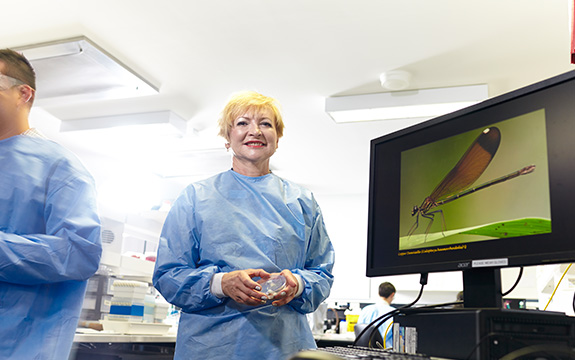Antibacterial solutions inspired by nature

In Summary
- This article featured in Swinburne's new ‘Research Impact’ magazine, produced in association with Nature Publishing Group
By mimicking the highly textured surface of insect wings, Swinburne University of Technology researchers hope to develop nano-structured materials that kill bacteria.
In 1945, scientists — including a pioneer of antibiotics Alexander Fleming — accurately predicted that microbes could develop resistance to antibiotics. Seventy years on, their warning has been realised as a significant healthcare challenge.
Elena Ivanova, a professor at Swinburne’s Faculty of Science, Engineering and Technology, and her research team, including scientists from a range of disciplines and universities, were studying self-cleaning surfaces in nature when they discovered bacteria being killed on the wings of the clanger cicada. Tiny spikes — nano-pillars — on the surface of cicada and dragonfly wings provide a physical rather than a chemical model for killing bacteria, which, when caught on the tips of the nano-pillars, stretch and rupture.
The team developed a biophysical model of the interactions, showing how the mechanical properties of bacteria, particularly cell rigidity, are key factors in determining resistance to the spikes. More rigid cells have a greater natural resistance to the effect. Further experiments found that using microwaves to irradiate bacteria cells reduced their rigidity, making them more susceptible to the destructive effects of the nano-pillars.
“There’s strong interest from biomedical industries,” says Ivanova, “Surface modification doesn’t change biocompatibility, mechanical or other properties of the implantable biomaterials. That means an implant with nano-structured surfaces could be used straight away.”
More work is necessary before practical applications are available, but the team is excited by its potential.
“This discovery is conceptually very new,” says Ivanova, “A lot of work has to be done. We have to learn how to fabricate nano-structured materials on large areas — an extremely challenging task. Our latest findings indicate that even a small variation in the nano-structure may result in decreased antibacterial activity.”
The need for new technologies and techniques to manufacture the required nano-structured materials opens new avenues for researchers. Once the technology is cracked, however, the commercial potential for the discovery is significant.
Bactericidal nano-surfaces can be applied to the metallic surfaces of biomedical implants. Antibacterial plastic surfaces could be used on biomedical plastic consumables such as catheters, as well as soft drink and water bottles, and bactericidal air and water purification filters. Antibacterial surfaces will also be valuable in the food handling industry and for surfaces subject to high levels of germs, such as those in public toilets.
Future research will focus on understanding more about the mechanisms through which nano-pillars mechanically rupture bacterial cells.
“This is critical for knowledgeable design of novel antibacterial nano-patterns, along with further research towards the development of larger scale nano-technologies,” says Ivanova.

